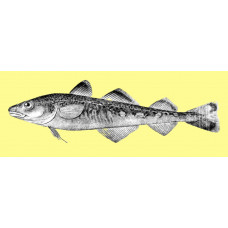Latin name
Eleginus nawaga
Other name
Arctic saffron, Atlantic navaga, Arctic cod
Identification
Eleginus nawaga is a close relative of E. gracilis, a related Pacific species.
Navaga are characterized by the presence of extensions at the ends of the transverse processes (ribs) of the vertebrae. The body is flattened near the abdomen (triangular in cross section). The mouth is inferior. Barbel normally developed. Side line slightly curved.
Features of fish fins
These fish have three dorsal and two anal fins separated by wide gaps. The caudal fin is almost without a notch.
Fish colouring
The coloration of the back and sides of the e Navaga is gray with brown or dark spots on the back, the belly is silvery white.
Distribution
This species is found in the European Arctic and subarctic waters of the Barents, White and Kara Seas, from Kola Bay to the mouth of the Ob River.
Habitat
A cold-loving Arctic coastal fish. It is almost never found in the open sea. It does not make large migrations. It is usually found at shallow depths, near soft-bottomed shores, near ice, and on the continental shelf.
Size
The largest specimen caught was a female with an absolute length of 47 cm and a weight of 700 g. The typical adult size is smaller and is only 15-25 cm in the White Sea, 40-42 cm in the Kara Sea. They live up to 13 years, in the White Sea up to 8 years.
Behavior
In winter, the navaga inhabits coastal waters where it spawns. It is often found in estuaries and freshwater. They return to open waters in the summer.
Food and feeding habits
These fish feed on crustaceans, bottom dwellers and small fish. Their diet includes polychaetes (Maldanidae, Phyllodocidae), small crustaceans (Amphipoda, Mysidae), small molluscs, fish eggs and fish (smelt, capelin, sand lance, saika, stickleback; juvenile flounder, whitefish, saffron cod, Cottidae).When the temperature rises to 10°, their feeding intensity decreases.
Reproduction
Spawning occurs only in December-January in seawater under ice at a depth of 8-10 m straits between islands, in places with strong currents and rocky or sandy bottom. Spawning is portioned. Fecundity varies from 6 to 88 (average about 23) thousand eggs with a diameter of 1.5-1.9 mm. Eggs sink to the bottom or float in the lower layers of water, but do not stick to the bottom. Spawning is mainly carried out by 2-4 (5) year old individuals. Egg development lasts up to 4 months.
Fishing
Commercial fishing of Navaga takes place mainly in winter in the bays of the White Sea, during the mass aggregation near the shores under the ice for spawning.
Relationship with a person
A fish that is harmless to humans. Its flesh is very tasty.
| Classification | |
| Phylum | Chordata |
| Class | Actinopterygii |
| Squad | Gadiformes |
| Family | Gadidae |
| Genus | Eleginus |
| Species | E. nawaga |
| Features | |
| Conservation status | Least Concern |
| Habitat | No information |
| Life span, years | 13 |
| Maximum body weight, kg | 0,7 |
| Maximum length, cm | 47 |
| Sailing speed, m/s | No information |
| Threat to people | Edible |
| Way of eating | Predator |
Navaga
Tags: navaga

